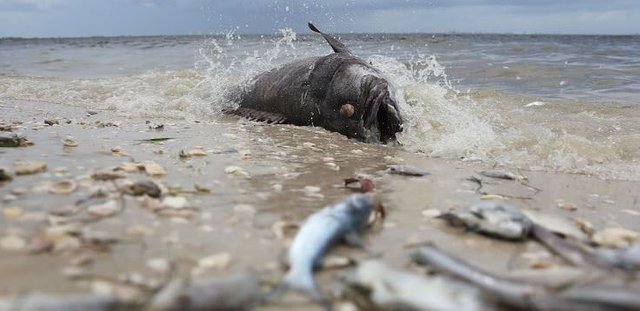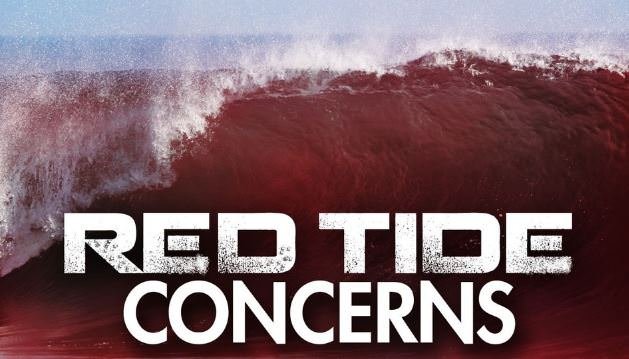For weeks now, thousands of dead fish, turtles, manatees, and dolphins have been washing upon beaches in southwest Florida. The culprit: Karenia brevis, a small toxic algae undergoing a massive bloom. It literally turns the waters red. It’s the worst so-called red tide the area has seen in over a decade, and experts say it’s far from over. The question on everyone’s minds, though, is why it’s so bad this year, and if this is a warning of things to come.

Algal blooms are exactly what they sound like: the rapid, massive proliferation of algae. They’re a natural part of many ecosystems, but they also can happen unnaturally in polluted waters because our waste fertilizes the bloom. Extreme algal blooms often spell trouble for aquatic life, but Floridian red tides can be especially devastating. Like other blooms, the sudden overabundance of these tiny, single-celled algae can kill fish and other creatures. That’s because when the algae die, they’re eaten by certain bacteria that can use up the oxygen in the water, leaving little left over for other species to breathe. They can also suffocate fish and other animals by directly clogging their gills. But Florida’s red tides are even more deadly because the algae responsible also produce potent neurotoxins called brevetoxins. These toxins open sodium channels in cells, causing muscles to clench inappropriately and messing with the immune system. When fish or shellfish consume the algae, intentionally or not, they get loaded with these toxins. Obviously that isn’t good for them, but it’s also not good us. Because even if the fish survive, they become dangerous to eat, which we like to do. The toxins are tasteless, odorless, and resistant to heat and acids, so you can’t easily tell if your food is contaminated, and normal cooking procedures don’t get rid of them. That’s why, during bad blooms like this, the government usually puts a moratorium on local shellfish. Eating contaminated seafood isn’t the only way these algal blooms harm people, either. Brevetoxins also have the rare ability to aerosolize. Wave action near the surface breaks apart the fragile algae, releasing their toxins into the air. When breathed in, these toxins can irritate your respiratory system, causing your eyes, nose, and throat to sting and burn, and inducing coughing and wheezing. I use to live in Florida. This has happened to me before. It’s not comfortable. It’s like somebody sprayed mace nearby. People with respiratory conditions like asthma are especially vulnerable, and while no human deaths have been attributed to red tides, the effects can send people to the ER.

Thankfully, symptoms are usually temporary and resolve quickly once you get away from shore. But they’re not fun. And unfortunately, marine mammals and turtles can’t escape the toxic air, or the toxins in their food. This year, it’s estimated that the red tide has killed several hundred turtles, dozens of manatees, and thousands upon thousands of fish, as well as dolphins, birds, and one poor whale shark. The die-offs are especially heartbreaking as many hard-hit species like the sea turtles are already endangered. And I mean, manatees were just moved from endangered to threatened last year. This year’s red tide is an especially awful one, with more than 160 kilometers of southwest Florida coastline already affected, and scientists are still trying to understand why it’s so bad. Red tides occur just about every year now, and there are records of them dating back centuries. So it’s not like these things are new. They start between 15 and 65 kilometers offshore in late summer or early fall, and sometimes stay entirely offshore. Usually, they only last a few months. But this bloom started over nine months ago and shows no signs of slowing down. There have been blooms in the past that have lasted years, so the duration isn’t unprecedented. But exactly what triggers the algae to flourish and why some blooms last while others don’t is still largely a mystery. There’s a lot of Internet speculation that particularly polluted waters from Florida’s Lake Okeechobee, which were released down a river this summer, are to blame for this year’s red tide. But experts are quick to point out that the tide began before those waters were released and far from where the river meets the sea. In fact, studies have largely failed to find connections between land-based pollution and the frequency of red tides. The tides seem to start too far offshore for runoff to be a major factor. So sorry, Internet. Things like the Lake Okeechobee water could be fueling the bloom now that it’s close to shore, though, by giving it all kinds of extra nutrients. Which might help explain why it’s still going. But even then, there are lots of other factors at play. Warmer waters from climate change may be increasing this year’s severity, as these and other algae seem to like things hot. And it’s possible last year’s notorious hurricane season also contributed to the current state of things, as hurricanes in the past have dragged nutrients offshore to fuel blooms. Scientists studying this year’s red tide won’t really have answers until they analyze the data they’re collecting and compare what’s happening now to previous years. But they expect the bloom to continue for a while, maybe even into next year. That means dead animals will continue to litter beaches where the bloom is worst, and local businesses already feeling lost tourism revenue will continue to struggle. So far, researchers haven’t found a great way to get rid of or control red tides, since it would require getting both the algae and the resulting brevetoxins out of the water. So the most we can do right now is hope that it ends quickly, for everybody’s sake and study it while it’s happening. If you want to keep up to date with how things are going in Florida, you can follow the Florida Fish and Wildlife Conservation Commission's regular updates, or NOAA’s harmful algal bloom warnings and forecasts. And the site visitbeaches.org, which is run by Mote Marine Laboratory, has updated conditions for popular tourist hotspots.
